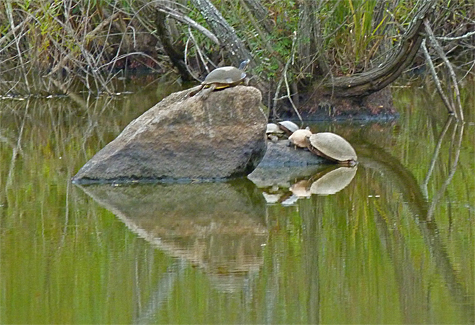With each passing cold front the temperatures are a little cooler, the humidity a little dryer, and winter a little closer. There’s plenty going on outside during this transitional time of year when we make the shift from summer to winter. It’s time to prepare for what’s to come and the birds, mammals, and insects are doing just that.

As the cicadas wind down so too the activities of the Cicada Killer. Hopefully their burrows are stocked with cicadas for their larvae to consume. The larvae will overwinter underground, pupate and emerge next summer to hunt their own cicadas.



While watching a hawk draw circles in the sky above the Wetlands I noticed a single Monarch butterfly high up and heading southwest, an obvious migrant. We don’t see much of the migration of Monarchs here in the Piedmont so any sighting of a Monarch is good news. However, from all accounts that I’ve read from the coast, including Cape May, New Jersey, the Monarch numbers are down from last year. The numbers are about even for the previous year, but that was a low number year as well. See for yourself at the official Monarch Monitoring Project web site.

Fall is the time of the spider. At this time of year arachnids need to catch as many insects in their webs as possible to sustain themselves and lay eggs so that their young may live on and hatch the following spring. The adults are destined to die at the first frost.

I don’t know what the fuss is about but our local Eastern Phoebe has been making quite a bit of noise lately. I’ve been seeing more than one phoebe, so perhaps a migrant has dropped into the Wetlands and is looking for a place to spend its winter, the local bird protesting the newcomer’s intentions.

Yesterday, I spotted both Red-eyed and White-eyed Vireos, Blackburnian Warbler, Northern Parula Warbler, Rose-breasted Grosbeak, and Summer Tanagers here at the Museum. This morning (9/25/13) I saw Summer Tanager, White-eyed Vireo and Magnolia Warbler. All of these birds are neotropical migrants and, along with a handful of others that I’ve seen the past few days, are here for a quick stopover on their way south.

If there is any doubt as to whether migration is underway, on one day this past weekend at Pilot Mountain State Park, NC, hawk watchers counted over 4,000 migrating hawks, more than 3,000 of which were Broad-winged Hawks. That same day at another hawk watch site, just south of the NC border in South Carolina (Ceasars Head State Park) hawk watchers counted over 12,000 hawks, more than 11,000 of which were broad-wings.
Nothing quite as dramatic here folks, but I did see a Sharp-shinned Hawk this morning (9/25/13). Sharp-shinneds don’t nest locally so that bird was obviously a migrant.
Snakes seem to be very active the past few weeks. The Northern Water Snakes in our Wetlands have been aggressively hunting frogs, perhaps in preparation of the upcoming long snooze in their winter dens.

Last week I saw a Black Racer hunting alongside the path in Explore the Wild, no doubt after some of the hundreds of young bullfrogs I saw hoping along the paths that week.

With the cooler weather, the Wetlands’ turtle population has been taking advantage of the basking opportunities. Excessive heat, like excessive cold, keeps the turtles under the water, mild temperatures with bright sun brings them out. Even so, as the temperatures drop further, most turtles will disappear beneath the water’s surface for the duration, but any warm spell during the winter may bring out a few yellow-bellieds for a brief bask in the sun.

And finally, squirrels. Yes, the local Gray Squirrels have been extremely busy eating and storing dogwood fruit, walnuts, acorns, pine nuts, and whatever else they can find around the campus here at the Museum.

The time has come to take action, and the wildlife have been listening to the call.
Beautiful pics, as usual Greg. I’ve never seen that detail on a cicada before.
Do we have any predators around here that eat turtles?
Thanks.
Once the turtles get through their first year they’re pretty much safe from predators here in our Wetlands. Up until then snakes, raccoons, probably possums, and herons will eat the little guys.
It’d be a different story if we had alligators in our Wetlands which could take all but the largest of our turtles for dinner.
I’ve known of birds of prey who would take turtles. Not being able to break the shell they’d fly high up and drop the turtles on a rock to get in at the meat.
There’s also a fascinating study done on Bald Eagles in the Chesapeake Bay area regarding turtle predation. Fifty one of 207 (about 25%) of the nests visited by researchers (for banding nestlings) were found to contain turtle shells of 5 species. I don’t think our turtles have much to fear from eagles, though. Although I see eagles circling over our wetlands on occasion, they all continue on their journeys without stopping to eat.